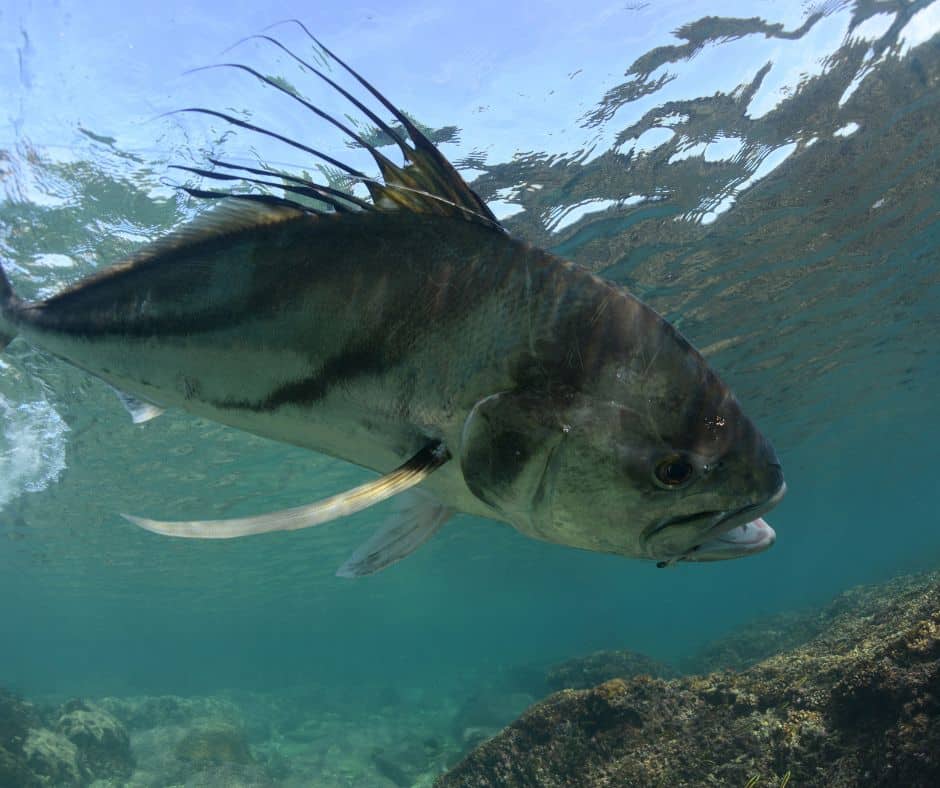Costa Rica is a land where adventure meets nature, culture blends with entertainment, wildlife thrives, and opportunities in real estate and business attract global attention. Among its many treasures, one experience stands out for thrill-seekers and anglers alike — the chance to battle the mighty roosterfish. With its unmistakable comb-like dorsal fin and reputation as one of the fiercest fighters in the Pacific, this iconic species presents a challenge that combines exhaustion, adrenaline, and sheer exhilaration. Whether you come for surfing, wildlife, dining, or business opportunities, chasing a roosterfish is an adventure that defines Pura Vida.
What is a roosterfish?
The roosterfish is instantly recognisable thanks to the seven bold spines that rise like a rooster’s comb along its back. These fish are built for power and speed, reaching lengths of over 1.5 metres and often topping 100 pounds. Found along rocky points, reefs, and river mouths, they are apex predators in Costa Rica’s Pacific waters. What truly makes them legendary, however, is not their size or looks, but the incredible fight they unleash when hooked.

Where in Costa Rica can you catch roosterfish?
Costa Rica’s Pacific coastline offers some of the best roosterfish grounds in the world. The northern regions of Guanacaste, including Tamarindo, Flamingo, and Papagayo, are popular hotspots with reliable charters and excellent waters. The Nicoya Peninsula, particularly Nosara and Samara, provides fantastic fishing opportunities with fewer crowds. Farther south, Drake Bay and the Osa Peninsula are famous for producing the largest specimens, all set against stunning backdrops of dense rainforest and remote, wild coastlines.
What does it feel like when a roosterfish bites?
The bite of a roosterfish is a jolt straight to your nervous system. One moment, the line sways lazily in the swell, and the next, it rips tight with a crack that makes your arms snap rigid. The reel erupts in a high-pitched scream, spilling line so fast it feels like the handle might melt under your hand. The rod bends violently, your palms burn against the grip, and before your brain catches up, adrenaline slams through your veins. The salt-heavy air stings your nose, the sun bakes your shoulders, and all you can hear is the ocean’s roar mixed with the furious whine of the reel. It’s not fishing anymore — it’s survival.
The fight: a thirty-minute battle of chaos and adrenaline
The first five minutes are pure shock. You dig in your heels against the rocking boat as the roosterfish bolts into the horizon, the line slicing through water like a knife. Your forearms tighten, your shoulders lock, and your grip starts to ache. Every surge feels like the ocean itself is dragging you overboard.
At ten minutes, your arms feel heavy, your muscles burn, and your hands sting with rope-like friction from the reel. Sweat runs into your eyes, mixing with salt spray, but you can’t stop. The roosterfish dives deep, then bursts upward, silver body flashing, dorsal comb cutting the surface like a crown. Your knuckles are raw, your back aches, and the sun feels merciless overhead, yet adrenaline pushes you beyond the pain.
By fifteen minutes, the fight feels endless. Your legs tremble with the effort of bracing, and your breath comes in sharp, ragged bursts. Every muscle protests, but you can’t let go. The roosterfish zigzags wildly, testing every ounce of skill and gear. The smell of salt and diesel from the boat mixes in the air as you focus only on the battle.
At twenty minutes, it becomes a war of attrition. Your hands are blistered, your arms quiver, and your shoulders scream, but still you lean back against each violent surge. The fish makes a final desperate sprint for the rocks, your rod bent nearly double, the line straining like a bowstring about to snap. You grit your teeth, steady your breathing, and fight back with everything left in you.
Finally, after thirty minutes of chaos, the roosterfish slows. You reel inch by inch, your arms rubbery and trembling, until it glides alongside the boat. Its silver flanks shimmer in the sunlight, spines raised defiantly like a warrior refusing to bow. You collapse back, soaked in sweat, your chest heaving, your body drained. But strangely, you don’t feel tired. The adrenaline masks everything. What you feel is triumph — raw, overwhelming triumph. You’ve not just caught a fish. You’ve gone toe-to-toe with one of the Pacific’s great predators and lived to tell the story.
When is the best time to fish for roosterfish in Costa Rica?
Roosterfish can be caught year-round in Costa Rica, but the dry season from December to April offers the best conditions, with calmer seas and clearer waters. The green season, from May to November, can still provide great opportunities, particularly near river mouths where baitfish gather. Local captains often recommend early mornings for the best chance of success, when cooler waters make the fish more aggressive.
How do locals view the roosterfish?
For Costa Ricans, the roosterfish is a symbol of ocean adventure and sustainability. Its reputation as a catch-and-release species makes it a cornerstone of eco-tourism. Because it is not prized as food, most roosterfish are released back into the ocean, preserving their populations for future generations. This approach reflects Costa Rica’s cultural respect for nature, where adventure and conservation go hand in hand.
What role does roosterfish tourism play in Costa Rica’s economy?
Roosterfish fishing plays a significant role in supporting coastal communities. Sportfishing charters employ captains, crews, and guides, while visiting anglers boost the local economy by staying in hotels, dining in restaurants, and even exploring real estate opportunities after experiencing life by the sea. The emphasis on catch-and-release reinforces Costa Rica’s image as a leader in sustainable tourism, allowing both people and nature to thrive.
Can you eat roosterfish?
Although technically edible, roosterfish are rarely eaten in Costa Rica. Their meat is considered strong and less desirable compared with species like snapper or mahi-mahi. For anglers, the true value of the roosterfish lies in the fight and the story — not on the dinner plate. By releasing them, visitors preserve the thrill of the chase for others while contributing to marine conservation.
FAQs about roosterfish in Costa Rica
Are roosterfish dangerous to humans?
No, roosterfish are not dangerous to swimmers or divers, though their power on the line is unmatched.
What bait works best for roosterfish?
Live bait, such as mullet or sardines, is the most effective, although large lures can also tempt them.
Do I need a licence to fish in Costa Rica?
Yes, a sportfishing licence is required, which can be purchased online or through charter companies.
What’s the biggest roosterfish ever caught in Costa Rica?
Roosterfish exceeding 100 pounds have been caught, particularly in the waters off the Osa Peninsula.
30 Minutes With a Roosterfish
The reel screams and the rod bends, nearly pulling you overboard. Your palms burn as the line whips out, and the salt-heavy air fills your lungs. Ten minutes in, your arms are on fire, sweat stings your eyes, and still the fish surges, zigzagging and leaping, its spines flashing like a crown in the sun. By fifteen minutes, you’re trembling, muscles screaming for mercy, but adrenaline roars louder than the pain. At twenty minutes, it makes a desperate run for the rocks, your rod bowing to the breaking point. You fight back, teeth clenched, lungs burning. Finally, after thirty minutes of chaos, the silver warrior glides alongside the boat. You collapse, shaking, drenched, exhausted — but all you feel is triumph. You haven’t just caught a fish. You’ve conquered a legend.

Contact: “Wishing I was Fishing” for your adventure
Book your trip with the top-rated charter in Marina Flamingo today!![]()
CONTACT US TODAY
![]() (+1 409) 330 1628
(+1 409) 330 1628
wishingiwasfishingadventures@gmail.com Facebook






